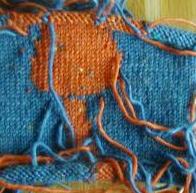![[return to the blue blog]](images/blueroom/blue_sheep_box.jpg)

the knitsmithy the blue blog - archives works in progress finished projects free patterns contact: alison [at] knitsmiths [dot] us |
|
march 3, 2003
knit and make up After a week of otherwise successful knitting, I decided to forgive the giranimals pocket for going bad on me and give it another try. I'm happy to say that it is progressing nicely, with no major problems so far.
[don'tcha just love intarsia?!] This time I've got the front of the jacket next to me while I work on the pocket so I can be sure that it's not turning out too small again. I've learned that I need to keep checking my knitting against the measurements given in the pattern's schematic. I've tried checking and rechecking gauge while knitting, but I don't find just checking a few inches here and there all that reassuring. Plus, my real question is, is this coming out the right size. So why not just measure that to check that nothing is going wrong? Which is why it really irks me when a pattern doesn't include all the measurements or a schematic at all. This Phildar pattern that I'm using for giranimals has great detailed diagrams for every piece, except the pocket. Okay, there's a color chart, but I'd have to count stitches and do the math to figure out the size. From the problems I've had with this pocket, you can tell that I didn't do that! (Dooh!) The Rowan pattern I'm using for greensleeves has a diagram with a few measurements like sleeve length to sleeve cap, but then no other specific measurements like sleeve width or sleeve cap length. Some of these are hidden in the instructions (i.e., knit until armhole measures 20 cm, then...), but how hard would it have been to write that in the diagram?! Well, since they didn't do it, I'm assuming that it's just about as hard as it would be for me to do the math myself, which as we noted above, I didn't bother to do either. For greensleeves, I decided to simply jot down measurements from a sweater of my own and work toward those. Perhaps I should add another step to my project preparation process. First swatch and then make up a detailed diagram, including any missing measurements from the pattern's schematic. Seems pretty straight-forward, I'm sure, for those unafraid of doing a little math. But I tend to get so many different answers when I count stitches, for example, that I don't have any faith in the results that I get. I suppose that in order to become a better knitter, I'll have to forgive math for going bad on me too. Hmmmm.... posted by alison at 7:31 am | in
giranimals
Comments
Yes, I do love intarsia, although sometimes I think I'm the only one. ;) Do you find it helpful to leave the ends pulled toward the front? I try to weave my ends in as soon as possible. I do them a few at a time as I go to minimize the dreaded 'weaving in' step at the end. More of that carrot and stick philosophy, balancing the fun with the fussing. I think your extra preparation step is an excellent idea. I have lots of scraps of paper with my various scribblings and ad hoc calculations. I could benefit from organizing better beforehand. Posted by: michelle at March 3, 2003 8:23 AMAlison, you must learn to love the math, become one with it, make it your friend! Or do what I did, marry an engineer! Good luck with the pocket. I know you can do it. Posted by: Chris at March 3, 2003 9:05 AMYay, Alison! I knew you'd get that pocket looking good. And I do agree with you re the schematics on that blasted chart; the pocket was the *only* thing that caused me a bit of a headache while doing the jacket. Everything else went smoothly. (How neat to see the ends poking through the front! Is it easier to work the intarsia that way? I've never seen anybody do intarsia, but taught myself from a book and I always keep the yarn at the back. I think I'll try your way next time.) Posted by: Becky at March 3, 2003 12:13 PMYikes, that's alot of ends to weave in. It looks like you'll soon be finished and it'll all be worth the effort. Looking forward to seeing a cute picture of both boys wearing their giranimals jacket. Posted by: Linda at March 3, 2003 12:14 PMHi everyone! I'm not done with the pocket/jacket yet. I'm keeping my fingers crossed that my little spate of good luck continues so I can finish it. As for having ends in the front of the work, I was taught to join ends that way when I took an intarsia workshop at my LYS last year. Place yarn between the needles with end hanging towards the front, then bring under old yarn and knit on. I don't know if it makes for a smoother join or has some other purpose, but it doesn't make any problems. Posted by: alison at March 3, 2003 2:01 PM |
